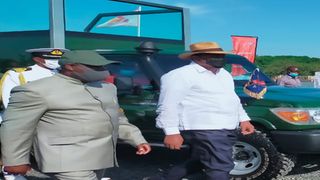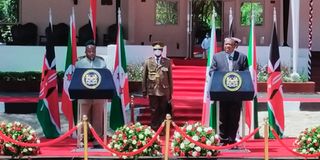
Burundi President Evariste Ndayishimiye and President Uhuru Kenyatta at the Kisumu port on May 31, 2021.
News
Premium
Madaraka Day: Why this is Kisumu’s day to shine
Kenya’s lakeside city, Kisumu, takes centre stage today as the country turns its focus on the Jomo Kenyatta International Stadium for this year’s Madaraka Day celebrations.
President Kenyatta and his Burundi counterpart Evariste Ndayishimiye are expected to lead the country in marking the day when, in 1963, the country attained internal self-rule after decades of colonial rule.
This is the first time since independence that Kisumu will host the national fete in line with the Jubilee administration’s policy of rotating the celebrations across the country.
The choice of Kisumu to host this year’s celebrations is particularly symbolic, coming on the final full-year of Mr Kenyatta’s presidency and four years into the “Handshake” agreement with opposition leader Raila Odinga.
Kisumu is Mr Odinga’s home city, and was particularly hard hit by the political violence that followed the disputed 2017 General Election.
The political truce between the two ushered in an era of intense national government attention on the region that has culminated in the launch of multiple development projects since Sunday.

Burundi President Evariste Ndayishimiye and President Uhuru Kenyatta during a press conference at the State Lodge in Kisumu on May 31, 2021.
Yesterday the President commissioned Kenya Shipyards Limited, the refurbished MV Uhuru cargo ship and the new Kenya Railways Marine School, which are key components of the revamped Kisumu port, as he promised to return later to finish launching the remaining projects.
Returning in August
High expectations that the President would open the entire port were, however, dimmed as the Head of State focused on components within the facility, with a promise of returning in August to launch the 216-kilometre Nakuru-Kisumu railway line.
“This is a dream our forefathers had, but died because of our weaknesses. We have started to revive the dream so that our youths will have good jobs. This dream is being actualised because of the peace we have,” the President said, referring to the fruits of the political détente with Mr Odinga.
The President said the full revival of Kisumu port will improve Kenya’s social and commercial relations with neighbouring countries, and reposition Kisumu city as a regional trade and logistics hub.
“With an international airport, a pier, and a railway station, this city will actualise the vision that the founding fathers of our three East African nations had in the East African Cooperation,” the President said. The official commissioning of the port will be done once the remaining works are completed, including dredging to allow more ships to dock, it emerged yesterday.
The delay to complete the Nakuru-Kisumu railway line and Uganda’s delay in finishing its port, including the oil jetty, has also played a role in the deferred port launch.
Port dredging, which Mr Odinga launched, began on February 10 with an August 10 finish date.
Building of a new ship
At least 128,000 tons of sludge has been dug up, attaining a depth of 4.5 metres.
Some 2,000 tons of sludge are removed in each of the four dredge trips made daily. The cumulative average depth before dredging was three metres.
Mango Tress Marine Limited is doing the dredging at Kisumu port and at the Mbita feeder port.
Upon completion, the port will have a port turning basin of 700 by 400 metres, with a Kenya Pipeline Company (KPC) access channel of 100m wide by 800m long to a KPC Turning Basin of 300m by 200m for the shallow waters and a deep water access channel of 100m wide and 4,000m long.
President Kenyatta and his Burundi counterpart Evariste Ndayishimiye speak at the launch of the Kenya Shipyards Limited in Kisumu County.
On the second day of his visit to Nyanza, President Kenyatta yesterday laid ground for building of a new ship to move more products across Lake Victoria to other East African countries.
On Monday, the President performed a keel-laying ceremony, setting the stage for the construction of the vessel MV-Uhuru II to complement the ageing MV Uhuru I that was recently refurbished and has made 50 trips to Port Bell and Jinja in Uganda, moving 50 million litres of fuel in three months.
Accompanied by Burundi’s President Ndayishimiye and Mr Odinga, seven cabinet secretaries and a host of leaders from the region, the President commissioned the Sh476 million Kenya Railways Marine School, the Kisumu Shipyard and flagged off MV Uhuru on its 51st trip.
President Kenyatta and his Burundi counterpart Evariste Ndayishimiye commission the new Kenya Railways Marine School on May 31, 2021.
MV Uhuru I was refitted by a team from the Kenya Defence Forces and successfully made its first trip to Uganda in December 2019 to deliver oil. At over 300ft (93 metres), it is the longest vessel on any of the East African lakes. It has 30 staff-23 crew and seven artisans.
It ferries petroleum products and packaged cargo. The vessel can make up to 10 round trips a month between Kisumu and Port Bell, depending on demand.
KDF soldiers refitted the main engines, navigation equipment, propellers, the hull, deck, generators and fire-fighting gear for MV Uhuru 1.
The nine-month refitting at Kisumu Shipyards began in 2019 before Kenya Shipyards was born and before renovations at the facility.
The President said having a shipyard in Kisumu will create jobs and opportunities for other businesses such as those dealing in steel.
Kenya Shipyards is a government-owned shipbuilding and repair facility. It was born out of the need for a maritime facility that can repair, maintain, refit, construct ships and provide other maritime services.
Phase one of the Kisumu shipyard has been completed with construction of an office block and the section building area. Phase two will encompass renovation of the dry dock and reconstruction of the rail wagon slipway. The Mombasa shipyard is under construction and will be completed soon.
Kenya Navy in partnership with Damen Civil Works Company, will run the shipyard.
President Kenyatta said construction of the new ship will create 1,000 new jobs. He berated those criticising him for using the military to revive collapsed parastatals and stalled development projects across the country.
He said his administration was spending less money on projects overseen by KDF as opposed to when they are managed by civilians or given to contractors from private firms, citing the Kenya Meat Commission, rehabilitation of the railway line and the Kisumu port.
President Kenyatta stated that his move to hand over KMC to the military was after the company was mismanaged twice during the Grand Coalition Government.
Lost to corruption
During retired President Mwai Kibaki’s era, the Head of State said, Sh1 billion was allocated to KMC, but was lost to corruption.
Another Sh2 billion was set aside during his time, yet KDF transformed the commission with less than Sh300 million.
He said KDF discipline, transparency and accountability is unmatched compared to agencies or parastatals run by civilian managers.
“If only these civilian managers or administrators could deliver a quarter of what the military does, we would be very far as a country. Those hands that carry guns also carry jembes (hoes) better,” he said.
Mr Kenyatta stressed the need to maintain peace, and warned leaders against wishing for or beating war drums.
“Peace allows many things to move and development to reign and this is why I’ll continue thanking my brother Raila for the handshake that brought peace in the country. Never underestimate the peace we have as Kenyans and don’t allow people to disturb that peace and shed blood,” he said.






